Click on images to enlarge
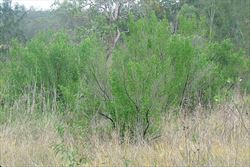
infestation (Photo: Sheldon Navie)
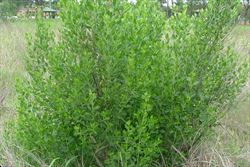
habit (Photo: Sheldon Navie)

habit of female plant in flower (Photo: Sheldon Navie)
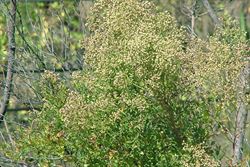
habit of male plant in flower (Photo: Sheldon Navie)

lower leaves (Photo: Sheldon Navie)
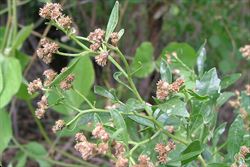
upper leaves and old male flower-heads (Photo: Sheldon Navie)
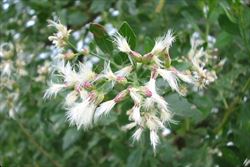
young female flower-heads (Photo: Sheldon Navie)
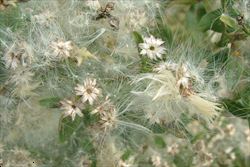
old female flower-heads (Photo: Sheldon Navie)
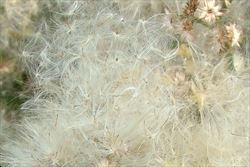
masss of seeds with fluffy hairs (Photo: Sheldon Navie)

close-up of seeds (Photo: Steve Hurst at USDA PLANTS Database)
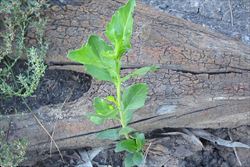
young plant (Photo: Sheldon Navie)
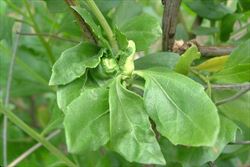
gall caused by the gall-fly biocontrol agent Rhopalomyia californica (Photo: Sheldon Navie)
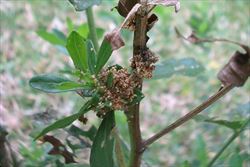
damage caused by the plume moth biocontrol agent Oidaematophorus balanotes (Photo: Sheldon Navie)
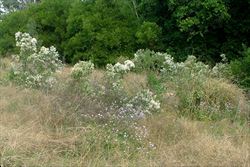
infestation near Woodford (Photo: Sheldon Navie)
Scientific Name
Baccharis halimifolia L.
Family
Asteraceae (Queensland, New South Wales, the ACT, Victoria, Tasmania, Western Australia and the Northern Territory)
Compositae (South Australia)
Common Names
consumption weed, eastern baccharis, groundsel, groundsel baccharis, groundsel bush, groundsel tree, groundselbush, groundseltree, Sea Island myrtle, tree groundsel, waterbrush
Origin
Native to eastern USA (i.e. Connecticut, Massachusetts, New Jersey, Rhode Island, Oklahoma, Alabama, Arkansas, Florida, Georgia, Maryland, North Carolina, South Carolina and Texas) and the Caribbean.
Cultivation
This species is usually not deliberately cultivated any more, though it may occasionally be found in old gardens.
Naturalised Distribution
A relatively widely naturalised species that is mostly found in eastern Australia. It is very common in south-eastern Queensland and north-eastern New South Wales, and is also present in other parts of these states (i.e. in central Queensland and in the coastal districts of central New South Wales). It was possibly also sparingly naturalised near Busselton in south-western Western Australia, but is no longer thought to be present in Western Australia.
Naturalised overseas in Europe and New Zealand.
Habitat
A weed of open woodlands, forests, waste areas, disturbed sites, coastal canals, swampy areas, estuaries, mangrove wetlands, pastures, forestry plantations, orchards, plantation crops, irrigation channels, creek banks (i.e. riparian areas), parks, gardens, roadsides and urban bushland. It is mainly present in warmer temperate and sub-tropical climates.
Habit
An upright (i.e. erect) and bushy shrub or small tree with many upward growing (i.e. ascending) branches. It usually grows 1-3 m tall, but occasionally reaches up to 7 m in height.
Distinguishing Features
- an upright bushy shrub (1-3 m tall) with much-branched stems that become woody with age.
- its waxy leaves (2.5-7.0 cm long and 1-4 cm wide) have coarsely toothed margins.
- it produces separate male and female flower-heads on separate plants.
- the male flower-heads are cream to yellowish, while the female flower-heads are white and have a fluffy appearance.
- its straw-coloured or brown seeds (about 3 mm long) and are topped with a silky tuft of long white hairs (up to 12 mm long).
Stems and Leaves
The much-branched stems are hairless (i.e. glabrous), finely ribbed lengthwise (i.e. striate), and green when young. They turn brown, become woody, and eventually develop a deeply fissured bark as they mature.
The alternately arranged leaves are loosely diamond-shaped (i.e. rhomboid) to egg-shaped in outline (i.e. ovate) and have coarsely toothed (i.e. crenate) margins. These leaves (2.5-7 cm long and 1-4 cm wide) are borne on stalks (i.e. petioles) up to 15 mm long and have a waxy texture. They are hairless (i.e. glabrous) and can have either pointed or rounded tips (i.e. acute or obtuse apices). Leaves tend to be light green when young and turn a dull green colour as they mature, and the upper leaves tend to be smaller and less toothed or even have entire margins.
Flowers and Fruit
Separate male and female (i.e. unisexual) flower-heads (i.e. capitula) are borne on separate plants (i.e. this species is dioecious). The male (i.e. staminate) flower-heads (about 3 mm across) are cream to yellowish in colour, while the female (i.e. pistillate) flower-heads (3-5 mm across) are white and tend to mature after the male flower-heads. These flower-heads (i.e. capitula) not not have any 'petals' (i.e. ray florets) and their bases are enclosed in a few layers (i.e. involucre) of green bracts. Both types of flower-heads are grouped in branched clusters at the tips of the stems (i.e. in terminal panicles). Flowering occurs mainly during autumn.
The 'seeds' (i.e. achenes) are straw-coloured to brown in colour and hairless (i.e. glabrous). These 'seeds' (1.1-1.7 mm long) have 8-10 lengthwise (i.e. longitudinal) ribs and are topped with a silky tuft (i.e. pappus) of long white hairs (6-12 mm long).
Reproduction and Dispersal
The female plants produce large numbers of light fluffy seeds. These seeds are blown large distances by the wind and float on water. They may also be dispersed by animals, vehicles, machinery, and in contaminated agricultural produce (e.g. fodder).
Environmental Impact
Groundsel bush (Baccharis halimifolia) is regarded as a significant environmental weed in Queensland and New South Wales. During a recent study it was listed as the second most important invasive plant species in south-eastern Queensland. It also rated highly in a survey of the most important environmental weeds of the New South Wales North Coast region. It is actively managed by community groups in Queensland and is also currently listed as a priority environmental weed in two Natural Resource Management regions.
This species is of most concern in sub-tropical melaleuca wetlands, where it can form a dense understorey that suppresses the growth of native sedges and interferes with the natural ecosystem. It can also become abundant in native vegetation along watercourses and in coastal woodlands and forests. Conservation areas are also under threat from invasion by this species, and it has invaded several reserves in Queensland (e.g. Noosa National Park, Maroochy River Conservation Park and Pimpama River Conservation Area) and New South Wales (e.g. Ballina Nature Reserve, Wooyung Nature Reserve and Cullendulla National Park).
Other Impacts
Groundsel bush (Baccharis halimifolia) will rapidly colonise overgrazed pastures and competes with pasture species for water and nutrients. Thick stands can inhibit the movement of livestock and reduce the productivity and carrying capacity of pastures. The air-borne pollen, which is produced in massive quantities for a short period of the year, is suspected of causing allergies in humans. The seed 'fluff'can also be a nuisance in urban areas, where it sticks to insect screens and accumulates in other areas.
Legislation
This species is declared under legislation in the following states and territories:
- New South Wales: Class 3 - a regionally controlled weed. The relevant local control authority must be promptly notified of the presence of this weed and it must be fully and continuously suppressed and destroyed (in a large number of local authority areas). See the New South Wales Department of Primary Industries Noxious Weeds List at http://www.dpi.nsw.gov.au for more detailed information on which local areas are covered in these declarations.
- Northern Territory: C - not to be introduced into the Territory.
- Queensland: Class 2 - landowners must take all reasonable steps to keep land free of this species (throughout the entire state). It is also illegal to sell a declared plant or its seed in this state.
- Western Australia: Prohibited - on the prohibited species list and not permitted entry into the state.
Management
For information on the management of this species see the following resources:
- the Biosecurity Queensland Fact Sheet on this species, which is available online at http://www.dpi.qld.gov.au.
- the New South Wales Department of Primary Industries Agfact on this species, which is available online at http://www.dpi.nsw.gov.au.
- the Northern Territory Department of Natural Resources, Environment and The Arts Agnote on this species, which is available online at http://www.nt.gov.au/weeds.

